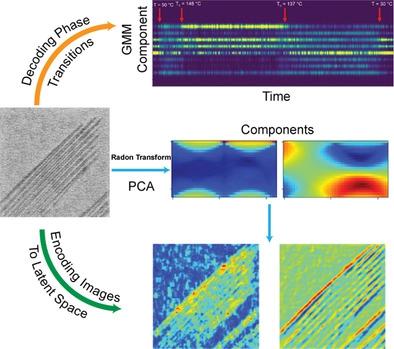Our official English website, www.x-mol.net, welcomes your
feedback! (Note: you will need to create a separate account there.)
Decoding the Mechanisms of Phase Transitions from In Situ Microscopy Observations
Small ( IF 13.0 ) Pub Date : 2022-09-05 , DOI: 10.1002/smll.202104318
Sai Mani Prudhvi Valleti 1, 2 , Reinis Ignatans 3 , Sergei V Kalinin 4 , Vasiliki Tileli 3
Small ( IF 13.0 ) Pub Date : 2022-09-05 , DOI: 10.1002/smll.202104318
Sai Mani Prudhvi Valleti 1, 2 , Reinis Ignatans 3 , Sergei V Kalinin 4 , Vasiliki Tileli 3
Affiliation

|
Analysis of the temperature- and stimulus-dependent imaging data toward elucidation of the physical transformations is an ubiquitous problem in multiple fields. Here, temperature-induced phase transition in BaTiO3 is explored using the machine learning analysis of domain morphologies visualized via variable-temperature scanning transmission electron microscopy (STEM) imaging data. This approach is based on the multivariate statistical analysis of the time or temperature dependence of the statistical descriptors of the system, derived in turn from the categorical classification of observed domain structures or projection on the continuous parameter space of the feature extraction-dimensionality reduction transform. The proposed workflow offers a powerful tool for the exploration of the dynamic data based on the statistics of image representation as a function of the external control variable to visualize the transformation pathways during phase transitions and chemical reactions. This can include the mesoscopic STEM data as demonstrated here, but also optical, chemical imaging, etc., data. It can further be extended to the higher dimensional spaces, for example, analysis of the combinatorial libraries of materials compositions.
中文翻译:

从原位显微镜观察解码相变机制
分析温度和刺激相关的成像数据以阐明物理转换是多个领域中普遍存在的问题。此处,BaTiO 3中的温度诱导相变使用通过变温扫描透射电子显微镜 (STEM) 成像数据可视化的域形态的机器学习分析进行探索。这种方法基于对系统统计描述符的时间或温度依赖性的多元统计分析,依次从观察到的域结构的分类分类或特征提取-降维变换的连续参数空间上的投影得出。所提出的工作流提供了一个强大的工具,用于基于图像表示的统计数据探索动态数据作为外部控制变量的函数,以可视化相变和化学反应期间的转化路径。这可以包括这里展示的细观 STEM 数据,还有光学、化学成像等数据。它可以进一步扩展到更高维度的空间,例如,分析材料成分的组合库。
更新日期:2022-09-05
中文翻译:

从原位显微镜观察解码相变机制
分析温度和刺激相关的成像数据以阐明物理转换是多个领域中普遍存在的问题。此处,BaTiO 3中的温度诱导相变使用通过变温扫描透射电子显微镜 (STEM) 成像数据可视化的域形态的机器学习分析进行探索。这种方法基于对系统统计描述符的时间或温度依赖性的多元统计分析,依次从观察到的域结构的分类分类或特征提取-降维变换的连续参数空间上的投影得出。所提出的工作流提供了一个强大的工具,用于基于图像表示的统计数据探索动态数据作为外部控制变量的函数,以可视化相变和化学反应期间的转化路径。这可以包括这里展示的细观 STEM 数据,还有光学、化学成像等数据。它可以进一步扩展到更高维度的空间,例如,分析材料成分的组合库。































 京公网安备 11010802027423号
京公网安备 11010802027423号